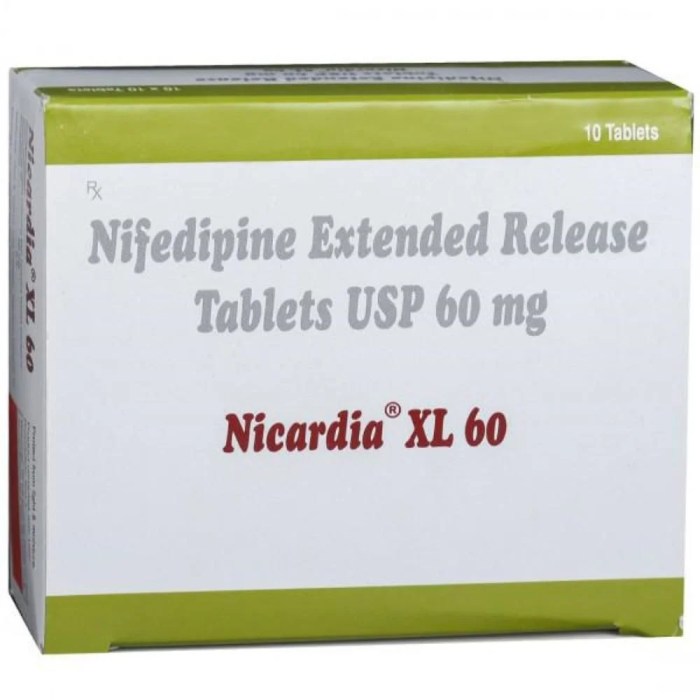Procardia, a calcium channel blocker, has established itself as a significant player in the realm of cardiovascular medicine. Its unique mechanism of action, targeting the smooth muscle cells of blood vessels, has revolutionized the treatment of various heart conditions. From managing angina to controlling high blood pressure, Procardia’s impact on cardiovascular health is undeniable.
This guide delves into the intricacies of Procardia, exploring its pharmacological properties, clinical applications, safety considerations, and alternative treatment options. We aim to provide a comprehensive understanding of this medication, empowering you with valuable insights for informed decision-making.
Procardia

Procardia, also known as nifedipine, is a medication primarily used to treat high blood pressure (hypertension) and chest pain (angina). It belongs to a class of drugs called calcium channel blockers, which work by relaxing the blood vessels and improving blood flow.
Mechanism of Action
Procardia works by blocking the entry of calcium ions into the smooth muscle cells of blood vessels. Calcium ions play a crucial role in the contraction of smooth muscle cells. By inhibiting calcium entry, Procardia relaxes the smooth muscle cells, leading to vasodilation (widening of blood vessels). This vasodilation reduces the resistance to blood flow, lowering blood pressure and reducing the workload of the heart.
Therapeutic Uses
Procardia is primarily used to treat the following conditions:
- Hypertension: Procardia helps to lower blood pressure by relaxing the blood vessels and improving blood flow.
- Angina: Procardia helps to reduce chest pain by improving blood flow to the heart muscle.
- Raynaud’s phenomenon: Procardia helps to improve blood flow to the hands and feet in people with Raynaud’s phenomenon, a condition that causes the blood vessels in the extremities to constrict in response to cold or stress.
Pharmacokinetics and Metabolism

Procardia undergoes various processes within the body, influencing its therapeutic effects and duration of action. These processes, collectively known as pharmacokinetics, involve absorption, distribution, metabolism, and excretion. Understanding these processes is crucial for optimizing drug therapy and minimizing potential adverse effects.
Absorption
Procardia is well-absorbed from the gastrointestinal tract, with peak plasma concentrations typically reached within 1 to 2 hours after oral administration. The absorption process is influenced by factors such as food intake, with higher peak concentrations observed when Procardia is taken on an empty stomach.
Distribution, Procardia
After absorption, Procardia distributes to various tissues throughout the body, including the heart, liver, and kidneys. The drug binds extensively to plasma proteins, primarily albumin.
Metabolism
Procardia undergoes significant metabolism in the liver, primarily through the cytochrome P450 system. The primary metabolic pathway involves oxidation and hydroxylation, leading to the formation of inactive metabolites.
Excretion
Procardia and its metabolites are primarily excreted in the urine, with a small amount eliminated in the feces. The elimination half-life of Procardia is approximately 3 to 5 hours, suggesting that the drug is eliminated relatively quickly from the body.
Half-life and Bioavailability
The elimination half-life of Procardia is approximately 3 to 5 hours. This means that the concentration of the drug in the body is reduced by half every 3 to 5 hours. The bioavailability of Procardia, which refers to the fraction of the drug that reaches the systemic circulation after oral administration, is approximately 80%. This indicates that a substantial portion of the drug is absorbed and reaches the bloodstream.
Drug Interactions
Procardia has the potential to interact with other drugs, leading to altered pharmacokinetic or pharmacodynamic effects. Some notable drug interactions include:
- Grapefruit Juice: Grapefruit juice can inhibit the metabolism of Procardia, leading to increased plasma concentrations and potentially enhanced effects or side effects.
- Strong CYP3A4 Inhibitors: Drugs that strongly inhibit the CYP3A4 enzyme, such as ketoconazole, itraconazole, and erythromycin, can increase Procardia levels and increase the risk of side effects.
- Other Calcium Channel Blockers: Concurrent use of other calcium channel blockers, such as diltiazem or verapamil, may lead to additive effects and increase the risk of hypotension or bradycardia.
Procardia’s role in cardiovascular care is multifaceted, offering a range of benefits for patients with specific conditions. While its effectiveness is well-documented, it’s crucial to approach Procardia therapy with awareness of its potential risks and side effects. Understanding the nuances of this medication, including its interactions with other drugs and individual patient factors, is paramount for optimal outcomes. This guide serves as a valuable resource, equipping you with the knowledge to navigate Procardia therapy effectively and confidently.
Procardia, a medication commonly used to treat chest pain and high blood pressure, can sometimes cause side effects. If you’re experiencing issues related to your medication, it’s crucial to consult with a medical professional. If you believe your workplace is contributing to your health issues, you may want to seek legal advice from labor lawyers near me.
They can help you understand your rights and explore options for addressing your concerns. Ultimately, prioritizing your health and seeking the right support is key when navigating potential medication side effects.